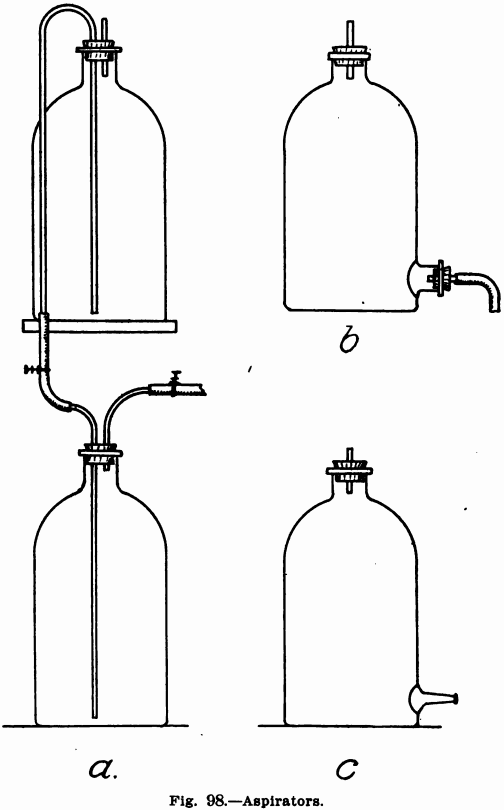The simplest form of aspirator consists of two large bottles, a, Fig. 98, both of which are tightly stoppered with rubber stoppers. Through each of these stoppers pass two tubes, one reaching from a few inches outside to within a fraction of an inch of the bottom of the bottle, the other reaching to just inside the stopper. The two long tubes are joined by rubber tubing and the flow of water through this is regulated by a Hoffman clamp on the tube. If air is to be sucked, the short tube of the upper bottle is to be connected with the apparatus from which the air is to be drawn. If air is to be forced through something, connection made between the latter and the short tube of the lower bottle.
An improvement on the above is a pair of regular aspirator bottles. These consist of bottles having a tubulature, or opening, at the bottom, b, Fig. 98. This is to be closed by a stopper having a short piece of glass tubing, over which is slipped the rubber tube connecting the two bottles. A better form of aspirator bottle has the tubulature drawn out so that the rubber tubing may be attached directly over this, c, Fig. 98.
An aspirator bottle may be made by boring a hole in an acid bottle, near the bottom, with a file dipped in turpentine, and then slipping into this hole a bit of glass tube covered with about an inch or so of soft thick walled rubber tubing.
Aspirators made of zinc, japanned and mounted so that continuous suction can be obtained for a long time without changing the connections, may be purchased. The small filter pumps described in Chapter III. may be used for suction, or the blast described in Chapter VI. for forcing air through an apparatus. If the pressure created by the latter is too great, the little regulator described blow may be used, This, Fig. 99, consists of a cylinder or bottle stoppered with a 2-hole cork or rubber stopper. One of the holes is left open and through the other passes a T-tube, one end of which dips into a little mercury in the bottle. The pressure of the gas is regulated by the distance into the mercury which the T-tube dips. Rubber tubes on which are Hoffman

clamps should be used to connect the upper branches of the T-tube, one with the blower and the other with the apparatus through which air is to be forced.
